
Trauma

Pleural and Peritoneal Fluid in EFAST Exam
Patient presented to the emergency department with atraumatic acute onset of shortness of breath. An EFAST was performed to evaluate for pneumothorax and assess for free fluid in the abdomen, thorax, and pericardium.
A significant right pleural effusion was present. Additionally, US of RUQ demonstrated a liver which appeared small in size with prominent ascites. This demonstrates the utility of POCUS to identify free fluid in a quick and efficient manner as compared to other common studies such as a CT scan, even in non-traumatic patients.
Contributors: Lauren Lowes, DO; Krishna Patel, DO; Julia Tu, MS-4
Central Michigan University Residency of Emergency Medicine

Hemoperotineum Or Not?
This is RUQ view from a patient who presented to the emergency department after falling from a roof and with low blood pressures. Although there appears to be perihepatic fluid, an interesting learning point form this case is whether or not we can discern if fluid observed is truly in the retroperotineal space or in the peritoneal cavity. Because the fluid is in direct contact with perinephric fat, this is actually in the retroperitoneal space and not in the peritoneal cavity. This may be difficult to distinguish in patients with very little perinephric fat.
Image courtesy of Robert Jones DO, FACEP @RJonesSonoEM
Director, Emergency Ultrasound; MetroHealth Medical Center; Professor, Case Western Reserve Medical School, Cleveland, OH
View his original post here

Subcapsular Splenic Hematoma
This is a clip of the LUQ performed during FAST exam following blunt trauma. It demonstrates loculated fluid around the spleen concerning for blood. CT imaging followed demonstrating a large subcapsular splenic hematoma.
Image courtesy of Robert Jones DO, FACEP @RJonesSonoEM
Director, Emergency Ultrasound; MetroHealth Medical Center; Professor, Case Western Reserve Medical School, Cleveland, OH
View his original post here

Hemoperitoneum
This clip was obtained in a patient presenting after a fall from roof. This hepatic window demonstrates an echogenic clot surrounded by a thin sliver of anechoic free fluid. This patient had massive acute hemoperitoneum. Remember that not all acute hemorrhage is anechoic!
Image courtesy of Robert Jones DO, FACEP @RJonesSonoEM
Director, Emergency Ultrasound; MetroHealth Medical Center; Professor, Case Western Reserve Medical School, Cleveland, OH
View his original post here

Splenic Rupture
Positive eFAST exam in a blunt trauma patient reveals abnormal splenic architecture and perisplenic fluid.
Image courtesy of Robert Jones DO, FACEP @RJonesSonoEM
Director, Emergency Ultrasound; MetroHealth Medical Center; Professor, Case Western Reserve Medical School, Cleveland, OH
View his original post here

Splenic hematoma with active extravasation
72 year-old male on Eliquis presented to the ED hypotensive after a fall. He was found to have left-sided rib fractures and ecchymosis. FAST was negative for intra-abdominal free fluid, pulmonary effusion, and pneumothorax but did show a splenic hematoma with a fluid jet and swirl (seen here). IR read the CTA as no active extravasation. After describing the ultrasound images the pt was taken to IR and had splenic artery angiography which confirmed extravasation, and was subsequently embolized with resultant hemodynamic stabilization.
Dr Alec Glucksman PGY-III @alecglucksman, Dr Anna Van Tuyl, Dr Norman Ng, Dr Joshua Greenstein
Northwell Health - Staten Island University Hospital

RUQ Free Fluid
A patient presented with LUQ trauma but the perisplenic window was negative for free fluid. Morison’s pouch was positive for free fluid emphasizing the importance of scanning all regions for free fluid in trauma.
Image courtesy of Robert Jones DO, FACEP @RJonesSonoEM
Director, Emergency Ultrasound; MetroHealth Medical Center; Professor, Case Western Reserve Medical School, Cleveland, OH
View his original post here

Hepatic Laceration
Seen in the superficial region of the liver is an easy to miss hepatic laceration. Ultrasound has a low specificity for detecting solid organ lacerations. Diagnosis was confirmed via CT.
Image courtesy of Robert Jones DO, FACEP @RJonesSonoEM
Director, Emergency Ultrasound; MetroHealth Medical Center; Professor, Case Western Reserve Medical School, Cleveland, OH
View his original post here

Positive FAST
Seen here is a subtle positive RUQ FAST scan in a trauma patient — a pertinent reminder to never stop simply after evaluating Morison's Pouch. Always also trace anteriorly to the lowest part of the liver.
Hjalti Már Björnsson
@hjaltimb

Gunshot Wound Foreign Body
Subcostal window in a patient with a gunshot wound revealed a hyperechoic structure with strong comet tail reverberation artifact. These findings are consistent with a metallic foreign body, such as a retained bullet in this patient. Visit the original post for a labelled image.
Image courtesy of Robert Jones DO, FACEP @RJonesSonoEM
Director, Emergency Ultrasound; MetroHealth Medical Center; Professor, Case Western Reserve Medical School, Cleveland, OH
View his original post here
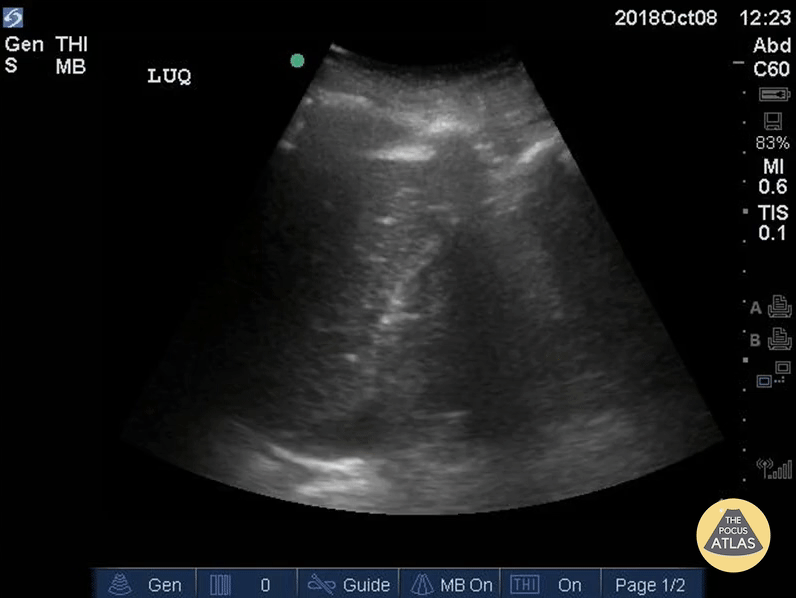
Subtle Positive FAST - LUQ
Positive FAST exam demonstrating free fluid in the left upper quadrant. Spontaneous hemoperitoneum in an anticoagulated patient with a left ventricular assist device (LVAD).
Dr. Elias Jaffa, MD

Free Fluid in LUQ
This image demonstrates free fluid in the LUQ. Notice the anechoic fluid seen both superior and inferior to the spleen as the probe is fanned. There is significant rib shadow appreciated obscuring parts of the image which makes the free fluid difficult to appreciate if not evaluated closely.

Positive LUQ View
This image demonstrates free fluid present in the left upper quadrant following blunt trauma to the abdomen. Notice the anechoic area present along the the pericolic gutter as well as between the spleen and the diaphragm consistent with free fluid.
Michael Macias, MD

Adrenal Hematoma
An adult male presented to the ED following a MVC with a fractured femur, right sided flank pain, and transient hypotension. FAST exam revealed an isoechoic, oval structure just cephalad to the right kidney indicative of an adrenal hemorrhage/hematoma.
Image courtesy of Robert Jones DO, FACEP @RJonesSonoEM
Director, Emergency Ultrasound; MetroHealth Medical Center; Professor, Case Western Reserve Medical School, Cleveland, OH
View his original post here

Retroperitoneal Hematoma
A young male presented to the ED following a 20 foot fall. He presented with LUQ pain, left flank pain, and soft vitals. FAST exam showed no fluid in Morison’s pouch or in the pelvis but revealed a large, left-sided, retroperitoneal hematoma noted by the distortion of the left kidney.
Image courtesy of Robert Jones DO, FACEP @RJonesSonoEM
Director, Emergency Ultrasound; MetroHealth Medical Center; Professor, Case Western Reserve Medical School, Cleveland, OH
View his original post here

Free Fluid in Morrison's Pouch
This 30-year-old male was brought to our ED after a fall from scaffolding with evidence of trauma to his right thoracoabdominal region. E-FAST performed in the RUQ revealed both the presence of free fluid within Morrison's pouch and an ipsilateral hemothorax. Appreciate the presence of “spine sign” as an additional ultrasonographic indicator of free fluid within the pleural space.
Renato Tambelli, Emergency Physician Hospital das Clínicas de Marília, Brazil.
@R_Tambelli // @JediPocus
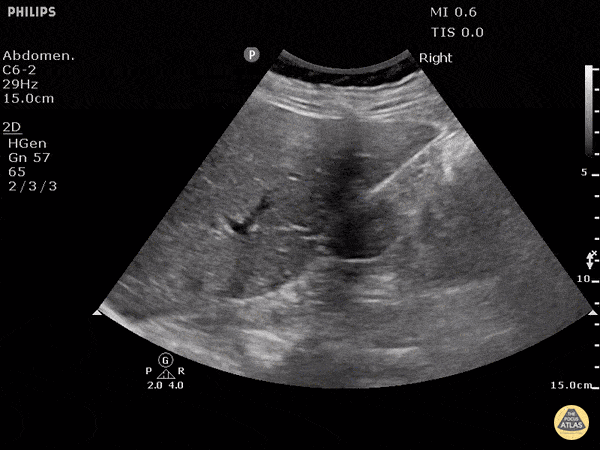
Normal FAST - RUQ
No free fluid in Morison's pouch.
Dr. Justin Bowra
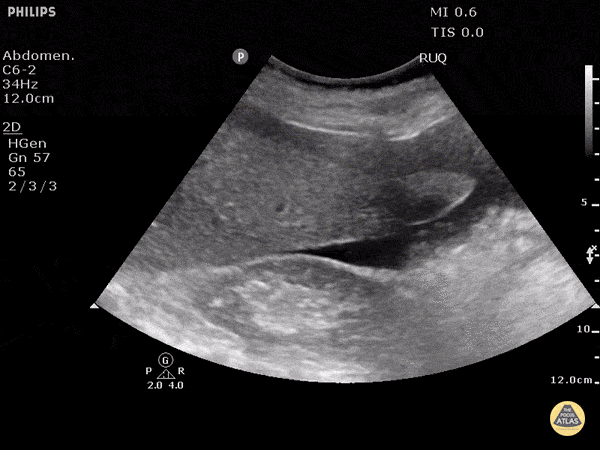
Positive FAST - RUQ - Morison's Pouch
Blunt trauma patient with POSITIVE FAST scan. The liver can been seen floating in free fluid with the kidney posteriorly. The fluid is in Morison's pouch. Be sure to visualize the tip of the liver to complete the evaluation.
Dr. Justin Bowra
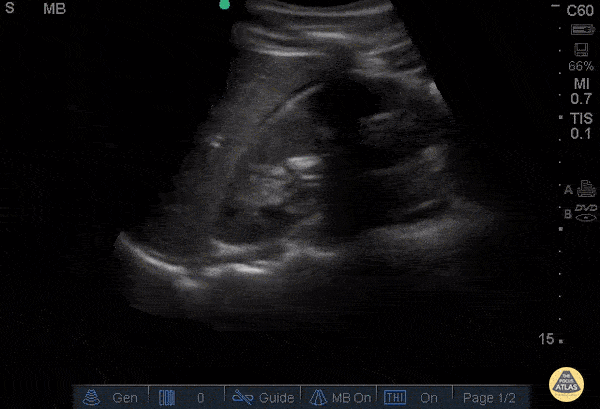
Positive FAST - RUQ
30 y/o pedestrian struck by car, hemodynamically unstable, tachycardic. FAST performed after primary survey revealed free fluid in all four abdominal views of the FAST exam
Free fluid in Morison’s pouch of the RUQ view. This is the most sensitive view to detect free fluid in trauma.
Dr. Catharine Bon - Kings County Emergency Medicine
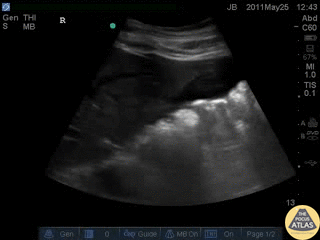
Positive FAST - RUQ
Blunt trauma patient with POSITIVE FAST scan. The liver can been seen floating in fluid with adjacent bowel.
Dr. Justin Bowra
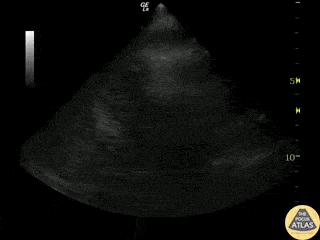
Normal FAST - LUQ
No free fluid is seen between the spleen and the diaphragm.
Dr. Justin Bowra
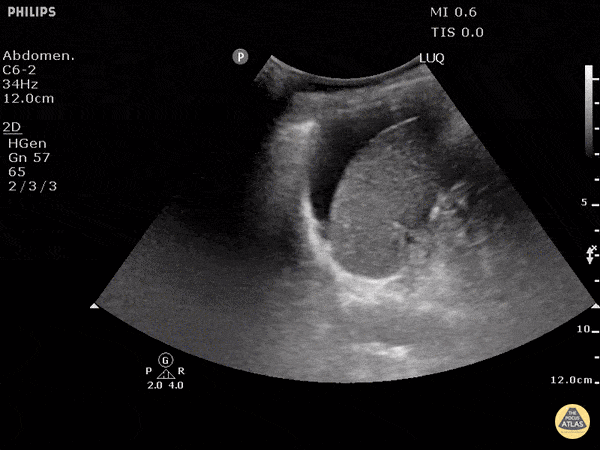
Positive FAST - LUQ
Blunt trauma patient with POSITIVE FAST scan. Free fluid can be seen between the spleen and the diaphragm in this LUQ view.
Dr. Justin Bowra

Normal FAST - Pelvis - Transverse
No free fluid is seen around or behind the bladder in this negative FAST.
Dr. Justin Bowra
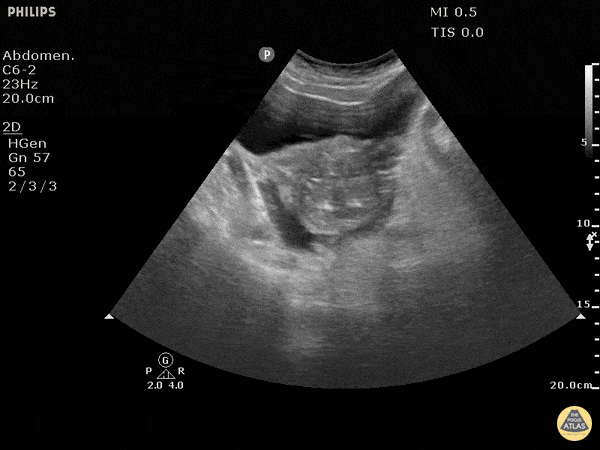
Positive FAST Pelvis - Transverse
Blunt trauma patient with POSITIVE FAST scan. The uterus can been seen floating in free fluid.
Dr. Justin Bowra
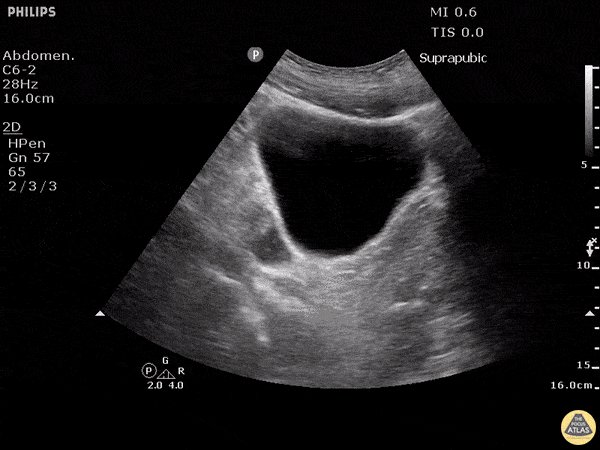
Positive FAST - Pelvis Transverse
Blunt trauma patient with POSITIVE FAST scan. Free fluid can be seen posterior and lateral to the bladder in this sagittal view.
Dr. Justin Bowra
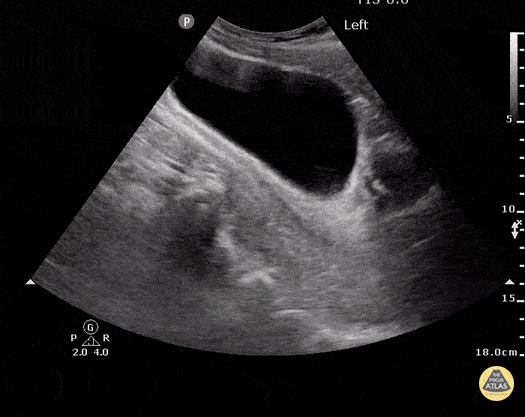
Normal FAST - Pelvis - Sagittal
No free fluid is seen behind the bladder in this sagital view.
Dr. Justin Bowra
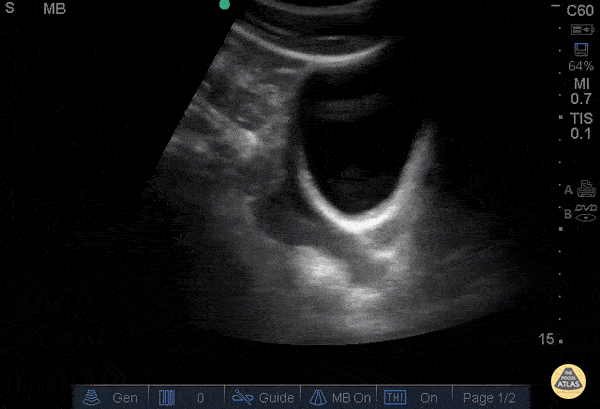
Positive FAST - Pelvis
30 y/o pedestrian struck by car, hemodynamically unstable, tachycardic. FAST performed after primary survey revealed free fluid in all four abdominal views of the FAST exam.
Free fluid seen superior and posterior to the bladder in this sagittal view.
Dr. Catharine Bon - Kings County Emergency Medicine

Ruptured Viscus From Blunt Trauma
Pt struck by car while riding bike. Perihepatic view on FAST exam revealed a perforated viscus (gastric rupture). Note the free air within the fluid.
Image courtesy of Robert Jones DO, FACEP @RJonesSonoEM
Director, Emergency Ultrasound; MetroHealth Medical Center; Professor, Case Western Reserve Medical School, Cleveland, OH
View his original post here.

Free Fluid within Abdomen
A 35-year-old woman presented to the ED after experiencing blunt abdominal trauma. She was hemodynamically unable. E-FAST Exam performed at bedside was notable for free intra-abdominal fluid (viewed here from suprapubic region). This rapid diagnosis enabled prompt disposition to the operating room.
Josiane Almeida, Emergency Physician; Sao Paulo- Brazil
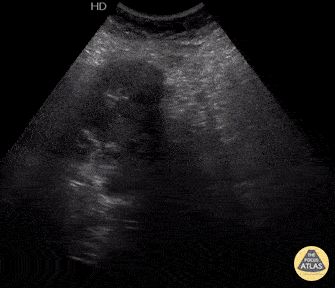
Ruptured Hepatic Hydatid Cyst
52-yo female presents to ED hypotensive with diffuse urticaria after blunt trauma to abdomen from a fall. FAST exam revealed a small amount of free fluid in RUQ and an abdominal mass. Diagnosis later confirmed to be a ruptured hepatic hydatid cyst.
Image courtesy of Robert Jones DO, FACEP @RJonesSonoEM
Director, Emergency Ultrasound; MetroHealth Medical Center; Professor, Case Western Reserve Medical School, Cleveland, OH
View his original post here
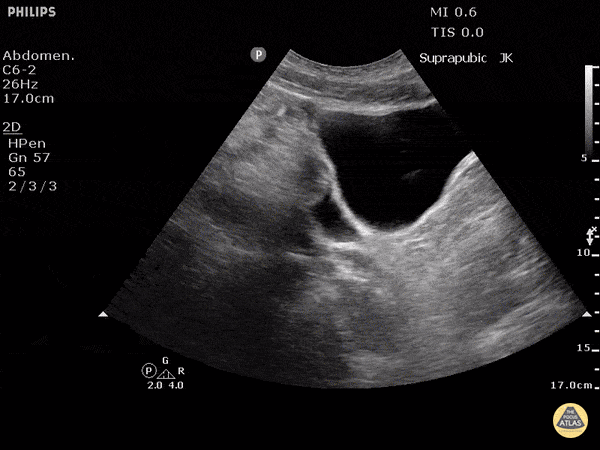
Positive FAST - Pelvis - Sagittal
Blunt trauma patient with POSITIVE FAST scan. Free fluid can be seen posterior to the dome of bladder in this sagittal view.
Dr. Justin Bowra

Traumatic Pneumoperitoneum (1/2)
8 year old boy after pushbike handles went into abdomen. Erect CXR suggested small pneumoperitoneum.
Initial POCUS in supine position showed normal RUQ, however this clip in left lateral position shows a small 'bubble' of air between liver and abdominal wall.
Dr. Justin Bowra

Traumatic Pneumoperitoneum (2/2)
8 year old boy after pushbike handles went into abdomen. Erect CXR suggested small pneumoperitoneum.
This image shows a lung curtain across the liver.
Dr. Justin Bowra
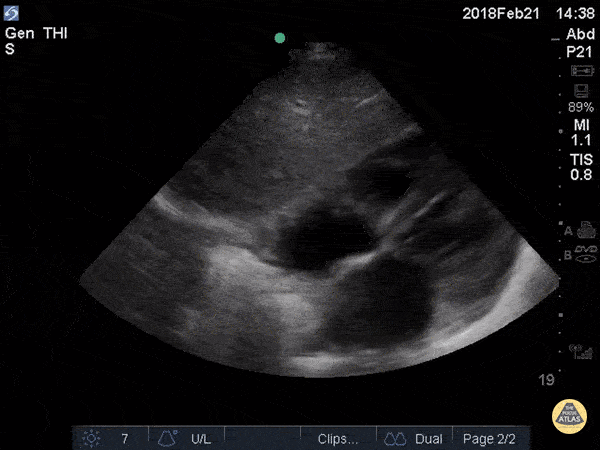
Subxiphoid
The most superficial structure we see is the liver. Immediately deep to that we see the heart separated from the liver by the diaphragm. Closest to the liver is the right atrium, tricuspid valve, and right ventricle. Deeper to that, we see the left atrium, mitral valve, and left ventricle. There is no anechoic fluid between the bright hyperechoic pericardium and the myocardium, indicating absence of pericardial effusion.
Hannah Kopinksi and Dr. Lindsay Davis - NYU Emergency Medicine
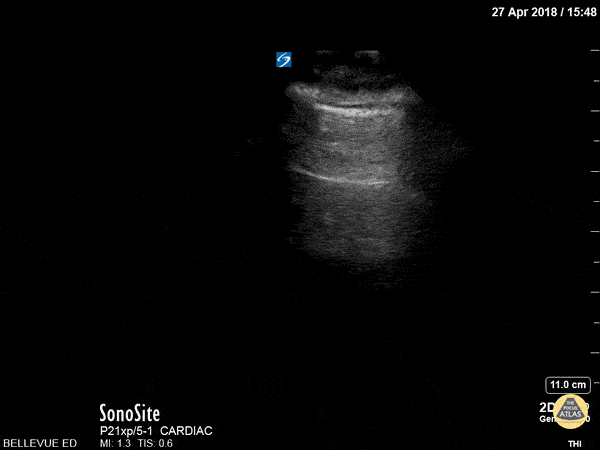
Lung Slide
This is a clip demonstrating lung sliding. The most superficial hyperechoic layers are the soft tissue and muscular layers of the chest wall. Immediately deep to that is a bright, thin hyperechoic line which appears to be in motion - this is the pleural line. The parietal pleura rubbing against the visceral pleura as the patient breathes creates this shimmery appearance of lung sliding, also often described as “ants marching”. Lung sliding indicates that there is no pneumothorax.
Hannah Kopinksi and Dr. Lindsay Davis - NYU Emergency Medicine

Free Peritoneal Fluid with Falciform Ligament
50s F found to be in cardiac arrest by EMS in the setting of 3 days hematemesis, achieved ROSC, and this image was seen on POCUS performed by EMS while packaging for transport. This subxiphoid view demonstrates the presence of organized cardiac activity with no large pericardial effusion, but free peritoneal fluid is seen adjacent to the liver, superficial to the diaphragm in this image, and the falciform ligament is also briefly seen.
Zachary Hutchins
South Metro Fire Rescue, Centennial, CO

Free Peritoneal Fluid from Splenic Injury
20s M presented with abdominal and back pain several hours after a fall off a ladder, and on FAST exam, had a large amount of free fluid seen in the pelvis/lower abdomen and in the RUQ. He was slightly tachycardic but normotensive, so underwent CT of the abdomen/pelvis, which demonstrated a significant spleen injury which was managed by IR embolization.
Dr. Greg Wiener, PGY3
Denver Health Residency in Emergency Medicine

+FAST in Morrison's Pouch from Splenic Injury
20s M presented with abdominal and back pain several hours after a fall off a ladder, and on FAST exam, had free fluid seen here in Morrison’s pouch, as well as a large amount of free fluid seen in the pelvis/lower abdomen. He was slightly tachycardic but normotensive, so underwent CT of the abdomen/pelvis, which demonstrated a significant spleen injury which was managed by IR embolization.
Dr. Greg Wiener, PGY3
Denver Health Residency in Emergency Medicine

+FAST Exam from Splenic Injury
20s M presented with abdominal and back pain several hours after a fall off a ladder, and on FAST exam, had a large amount of free fluid seen in the pelvis/lower abdomen and in the RUQ. He was slightly tachycardic but normotensive, so underwent CT of the abdomen/pelvis, which demonstrated a significant spleen injury which was managed by IR embolization.
Dr. Greg Wiener, PGY3
Denver Health Residency in Emergency Medicine

RUQ +FAST
A teenage male patient presented to the ED after a helmeted mountain bike crash, and due to mechanism, underwent a bedside FAST exam, which was positive in the RUQ as well as suprapubic views. CT demonstrated a grade 4 spleen laceration as well as multiple buckle rib fractures, and he was admitted for observation.
Dr. Gabe Siegel, PGY-2 and Dr. Michael Kidon, PGY-4
Denver Health Residency in Emergency Medicine

Subtle RUQ +FAST
30s F presented with worsening abdominal pain in the setting of a known ectopic pregnancy. FAST exam was very subtly positive in the RUQ, with more free fluid seen in the pelvic/suprapubic view. This clip shows the RUQ view, and a trace amount of free fluid is seen at the liver tip, highlighting the importance of complete visualization of this area when viewing the RUQ. This patient remained hemodynamically stable, and so was managed expectantly rather than with surgical exploration.
Dr. Lindsay Howe, PGY-3
Denver Health Residency in Emergency Medicine

Pelvic +FAST from Spleen Lac
20s F presented with presyncopal episode after standing electric scooter crash. She had been evaluated at an urgent care where she had dental injuries identified, but was initially hemodynamically stable. She arrived to the ED tachycardic and hypotensive, and FAST exam was positive in the pelvic view as shown here in transverse and sagittal orientations. She was resuscitated with massive transfusion protocol and responded well. CT scanning showed a grade 2 splenic laceration. The patient was admitted for further observation and serial CBC checks.
Dr. Larry Benjey, PGY-3
Denver Health Residency in Emergency Medicine
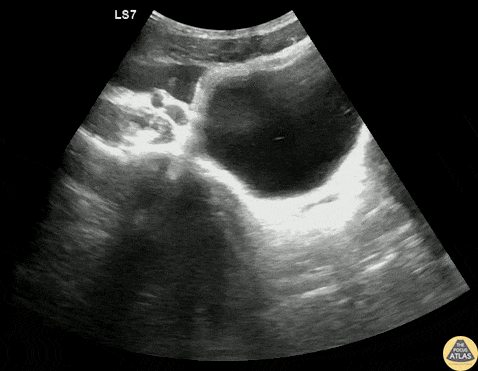
Pelvic +FAST from Splenic Injury
A teenage male patient presented to the ED after a helmeted mountain bike crash, and due to mechanism, underwent a bedside FAST exam, which was positive in the RUQ as well as suprapubic views. CT demonstrated a grade 4 spleen laceration as well as multiple buckle rib fractures, and he was admitted for observation.
Dr. Gabe Siegel, PGY-2 and Dr. Michael Kidon, PGY-4
Denver Health Residency in Emergency Medicine

Suprapubic +FAST from GSW
20s M presented as a walk in after sustaining a GSW to the hip. He was initially hemodynamically unstable, however responded well to transfusion of blood products and vitals normalized. FAST exam of the suprapubic/pelvic area is shown here, with heterogenous free fluid seen best in the sagittal view. FAST was also positive in the RUQ and LUQ. Plain films demonstrated a retained missile in the abdomen. As he was hemodynamically stable, CT of the abdomen and pelvis was obtained, showing hemoperitoneum and free air concerning for bowel and vascular injury. The patient was taken emergently to the OR, where exploratory laparotomy demonstrated a pelvic hematoma and hemoperitoneum from an iliac vein injury, as well as multiple areas of small bowel injury. His injuries were repaired, he recovered well, and was discharged within days of his injury.
Dr. Ian Eisenhauer, PGY1
Denver Health Residency in Emergency Medicine

Subtle +RUQ FAST from GSW
20s M presented as a walk in after sustaining a GSW to the hip. He was initially hemodynamically unstable, however responded well to transfusion of blood products and vitals normalized. FAST exam of the RUQ is shown here, with a trace amount of free fluid seen along the liver tip. FAST was also positive in the LUQ and pelvic views. Plain films demonstrated a retained missile in the abdomen. As he was hemodynamically stable, CT of the abdomen and pelvis was obtained, showing hemoperitoneum and free air concerning for bowel and vascular injury. The patient was taken emergently to the OR, where exploratory laparotomy demonstrated a pelvic hematoma and hemoperitoneum from an iliac vein injury, as well as multiple areas of small bowel injury. His injuries were repaired, he recovered well, and was discharged within days of his injury.
Dr. Ian Eisenhauer, PGY1
Denver Health Residency in Emergency Medicine













































